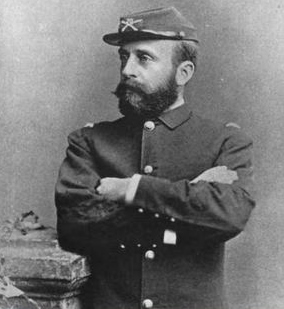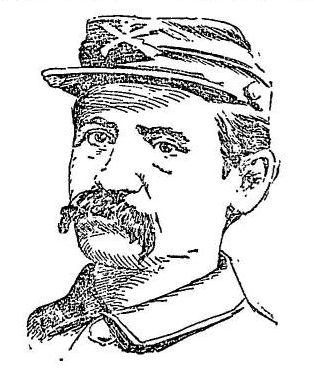The 1st Wisconsin Infantry Regiment was a volunteer infantry regiment in the Union Army during the American Civil War.

The 105th Pennsylvania Volunteer Infantry was an infantry regiment which served in the Union Army during the American Civil War. Among the regiment's early recruits was future United States Congressman Albert C. Thompson.

Sylvester Bonnaffon Jr. was a United States soldier who fought with the Union Army during the American Civil War as a first lieutenant with Company G of the 99th Pennsylvania Infantry. He received his nation's highest award for valor, the U.S. Medal of Honor, for his gallantry and leadership against Confederate troops during the Battle of Boydton Plank Road, Virginia on October 27, 1864. That award was conferred on September 29, 1893.

John Wainwright was a United States military officer during the American Civil War. A native of Syracuse, New York, he was awarded his nation's highest award for valor, the Medal of Honor, for his "gallant and meritorious conduct" while serving in the Union Army as a first lieutenant with the 97th Pennsylvania Infantry during the Second Battle of Fort Fisher, North Carolina on January 15, 1865.
Company "A", Pennsylvania (Colored) Infantry was a United States Colored Troops unit briefly formed during the Civil War in the Union Army. The unit was organized at Camp William Penn, Pennsylvania on July 28, 1864 It was named for its commander, Captain Converse Southard. The unit was disbanded November 14, 1864 at Philadelphia, Pennsylvania and its remaining members sent to reinforce existing U.S.C.T. regiments.

The 27th New Jersey Infantry Regiment was an American Civil War infantry regiment from New Jersey that served a nine-month enlistment in the Union Army. It was the only nine-month Regiment from New Jersey with an eleventh Company.
The 75th Regiment Pennsylvania Volunteer Infantry was a unit of the Union Army during the American Civil War. It was composed almost entirely of German-speaking residents of Philadelphia and newly arrived German immigrants. Total enrollment, over the course of the war, was 1,293 officers and men. The 75th Pennsylvania participated in several major battles including Second Bull Run, Chancellorsville, and Gettysburg. The regiment was transferred to the Western Theater in September, 1863. There, it participated in operations in Tennessee, before it was mustered out of service on September 1, 1865, following the close of the war.

Samuel Rex Russel was a Corporal in Company B of the 25th Regiment of the Pennsylvania Infantry in the American Civil War from April 18, 1861 to July 29, 1861. He was discharged with the rank of First Sergeant. He rejoined as a Second Lieutenant of Company C of the 96th Regiment on September 23, 1861 and was promoted to Captain of Company H. He was discharged on May 1, 1863.

John Wallace Scott, also known as J. Wallace Scott, was a United States soldier who fought with the Union Army as a member of several Pennsylvania infantry units during the American Civil War. Severely wounded during the Siege of Petersburg in 1864, he was recognized for his meritorious service less than eight months later with his nation's highest award for bravery, the U.S. Medal of Honor, for capturing the enemy's flag while serving as captain of Company D of the 157th Pennsylvania Infantry during the Battle of Five Forks, Virginia on April 1, 1865. That award was conferred on April 27, 1865.

The 97th Pennsylvania Infantry was a Union infantry regiment which fought in multiple key engagements of the American Civil War, including the Siege of Fort Pulaski, Bermuda Hundred Campaign, Battle of Cold Harbor, Siege of Petersburg, and the Carolinas Campaign.

The 47th Pennsylvania Infantry Regiment, officially the 47th Regiment, Pennsylvania Volunteer Infantry and sometimes referred to simply as the 47th Pennsylvania Volunteers, was an infantry regiment that served in the Union Army during the American Civil War and the early months of the Reconstruction era. It was formed by adults and teenagers from small towns and larger metropolitan areas in central, northeastern, and southeastern regions of Pennsylvania.

The 1st Pennsylvania Infantry was an infantry regiment in the Union Army during the American Civil War that served for three months at the beginning of the war.

The 4th Pennsylvania Infantry Regiment, officially known as the 4th Regiment, Pennsylvania Volunteer Infantry, was an infantry regiment of the Union Army in the American Civil War. Formed mostly from a militia unit in Norristown in southeastern Pennsylvania, the regiment enlisted at the beginning of the American Civil War in April 1861 for a three-month period of service under the command of Colonel John F. Hartranft. Logistical difficulties bedeviled the regiment, which served as part of the garrison of Washington, D.C., until late June, when it was sent into Northern Virginia to join in the army of Brigadier General Irvin McDowell.
George Warren Alexander (1829-1903) was a New Hampshire native who made significant contributions to the communities of Reading and West Reading in Berks County, Pennsylvania, from the mid-1800s to the early 1900s.

The 12th Regiment Pennsylvania Volunteer Infantry was an infantry regiment of the Union Army in the American Civil War. Raised in Pittsburgh and its surrounding counties in April 1861 for three months of service, the regiment spent its first month in training, then guarded the Northern Central Railway in Maryland until it was mustered out. Many of its men went on to serve in subsequent Pennsylvania regiments during the war.

The 157th Pennsylvania Volunteer Infantry was a Union infantry regiment which fought in multiple key engagements during the final years of the American Civil War, including the Battle of Cold Harbor, Siege of Petersburg, and Appomattox Campaign. One of two military units raised at roughly the same time in the Philadelphia area during the fall of 1862, the 157th Pennsylvania was stationed initially at Fort Delaware, beginning in December 1862, and remained there on garrison duty until it was reassigned to the defense of Washington, D.C. during the early winter of 1863. It was then assigned to the Army of the Potomac during the spring of 1864, and sent to the front lines of the war's Eastern Theater, where it remained for the duration of the war. During a reorganization of Union Army units in the spring of 1865, its men were merged with those of the 191st Pennsylvania Infantry.

Alexander H. Mitchell was a United States military officer who fought with the Union Army during the American Civil War as captain of Company A of the 105th Pennsylvania Infantry. Wounded multiple times in combat during the war, he was awarded the Kearny Cross for his distinguished service in the Battle of Chancellorsville, Virginia in May 1863, and was then also awarded his nation’s highest award for valor, the U.S. Medal of Honor for his capture of a Confederate flag in hand-to-hand combat with the color-bearer of the 18th North Carolina Infantry during the Battle of Spotsylvania Court House on May 12, 1864.

William Sands was a United States soldier who fought with the Union Army during the American Civil War as a principal musician with the 88th Pennsylvania Infantry and, later, as a first sergeant with that same regiment. He received his nation's highest award for valor, the U.S. Medal of Honor, for capturing an enemy flag and carrying it from behind Confederate States Army lines to those of the Union Army during the Battle of Dabney's Mill/Hatcher's Run, Virginia. That award was conferred on November 9, 1893.
The 25th Pennsylvania Volunteer Infantry was a Three Months' Service infantry regiment which served with the Union Army during the American Civil War. Composed of Pennsylvania First Defenders, the first five companies of men who responded to President Lincoln's call for 75,000 volunteers to defend the national capital in Washington, D.C. following the Fall of Fort Sumter to Confederate States Army troops in mid-April 1861, and five additional companies of early responders who enlisted later in April 1861.

The 24th Pennsylvania Volunteer Infantry was a three-month infantry regiment that served in the Union Army during the American Civil War.














